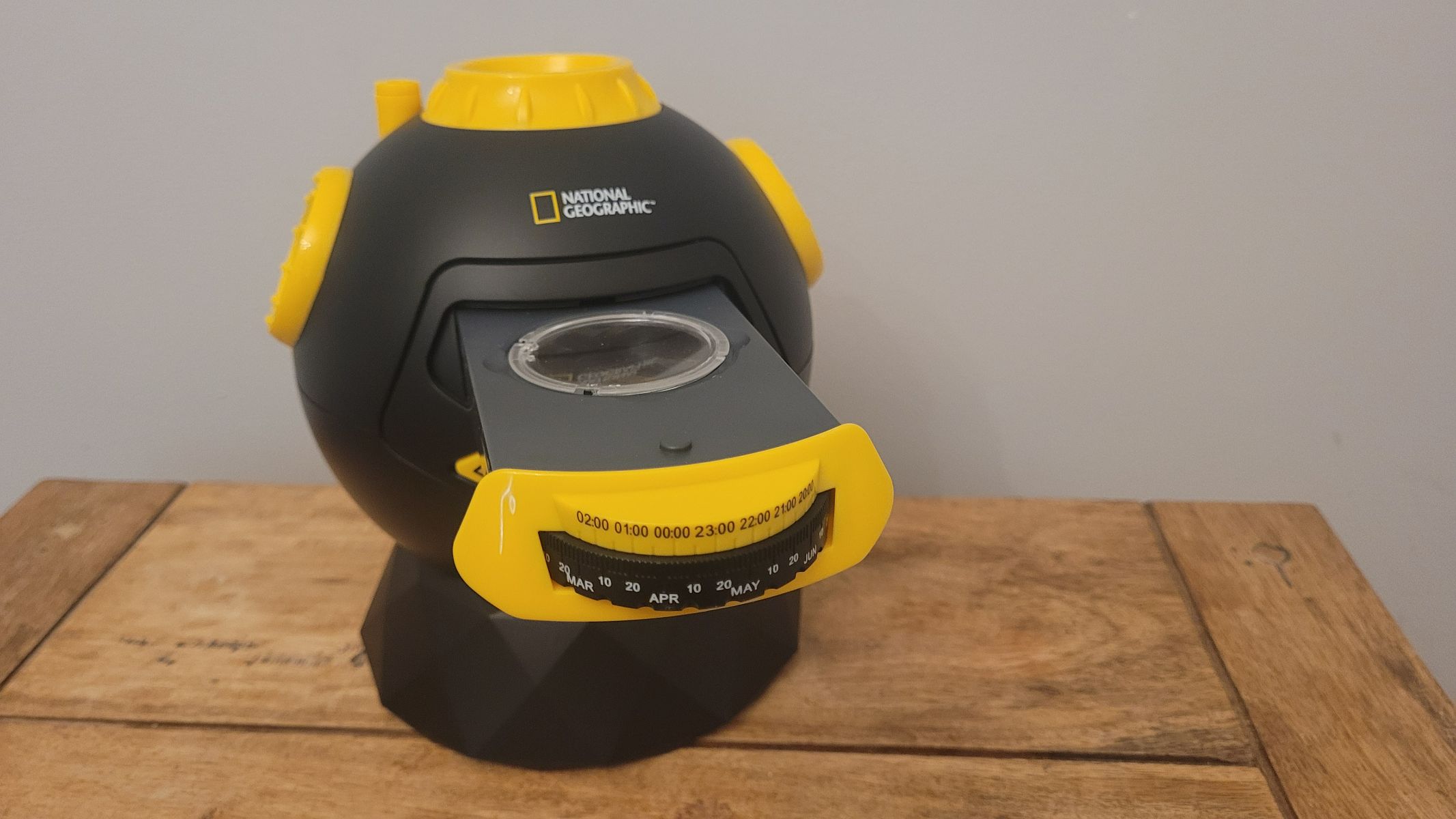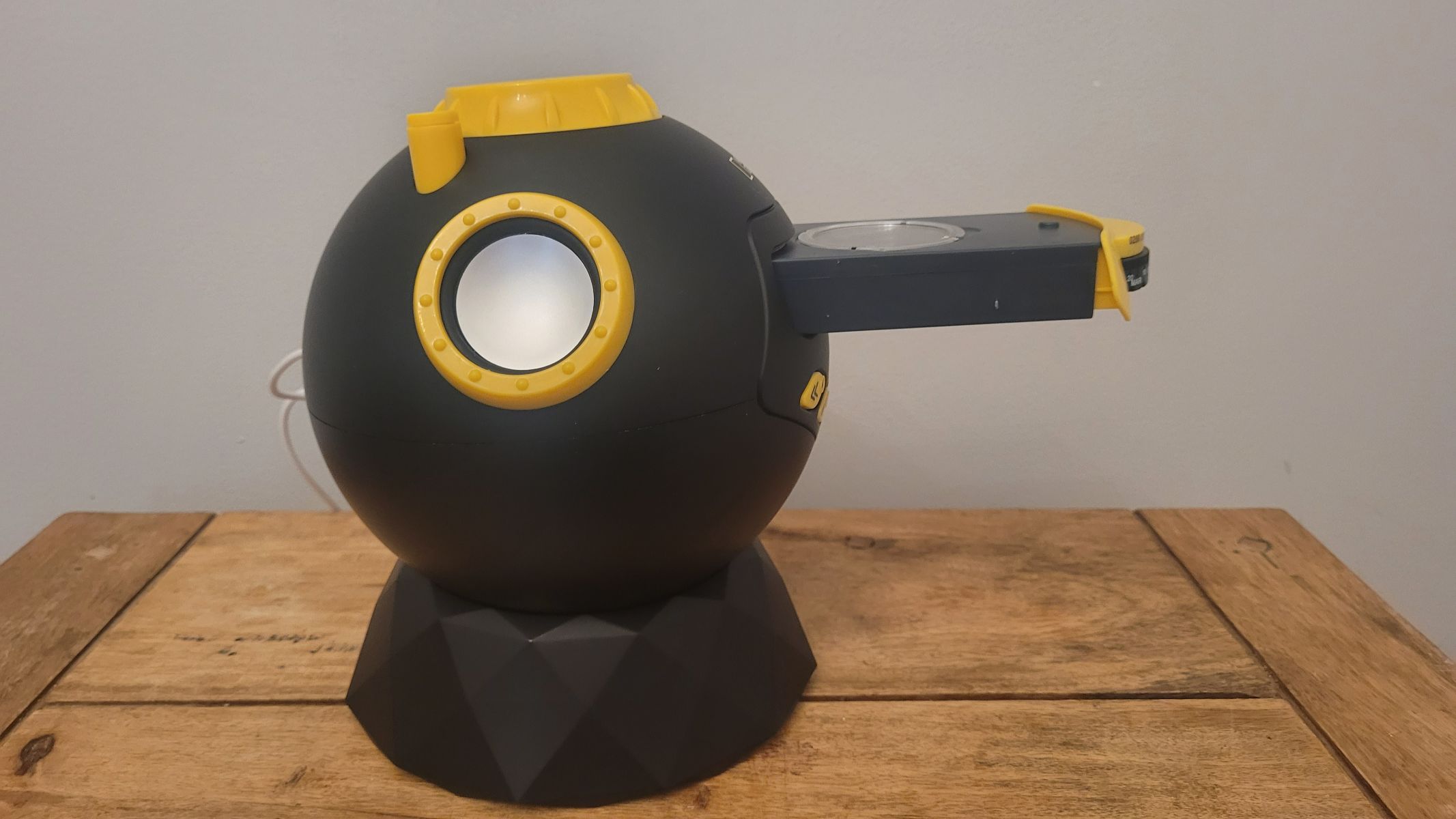Space Verdict
The National Geographic Astro Planetarium has more functionality than its Homestar Flux rival, with a time and date selector and built-in speaker being additional features. The design isn't as sleek, but its suited to a younger audience as well. This is a good learning tool and would make a nice space gift for a budding astronomer or someone that wants to unwind.
Pros
- +
Projections true to chosen time and date
- +
Five-year warranty
- +
Integrated speaker
- +
Additional discs available
Cons
- -
Yellow accents make it look a little toyish
- -
No Bluetooth connectivity to speaker
- -
We couldn't make the in-built radio work
Why you can trust Space.com
Size: 6.3 x 6.3 x 7.5 inches
Bulb Type: LED
Rotation: Yes
Sleep timer: Yes
Speaker: Yes
Projection Surface: 1.6 x 2.2 m (at 2 m distance)
We've tested a number of star projectors but the National Geographic Astro Planetarium is the first one we've had our hands on which is true to the selected time and date. Prior to the review, we assumed it would be more in line with the quality and functionality of the Sega Toys Homestar Flux as opposed to other star projectors like the BlissLights Sky Lite 2.0 that focus less on scientific accuracy, and more on creating a colorful and immersive atmosphere — it turns out our assumptions were correct.
As with many products, the price does fluctuate quite drastically and can be remarkably different across different retailers. You should be able to see today's best deals at the top of this page.
Despite being called the National Geographic Astro Planetarium, it is made in collaboration with Bresser, which is a German company offering an extensive range of high-quality and reliable electronic products. We put it to the test to see if it can stand up to the stiff Sega Toys competition and keep its place in our best star projectors buying guide.
Alternatively, if you want to look at the real night sky you may need a hand picking from one of the best telescopes or best telescopes for beginners if you're new to astronomy.
National Geographic Astro Planetarium: Design
- Yellow accents make it look a bit toyish
- Intuitive buttons
- Flexible positioning options
The home planetarium is ultimately a small globe that can be placed on the included stand at almost any angle. Although we understand that it is designed in the colors of National Geographic branding, we think the yellow is a bit garish and toy-like and doesn't look as sleek as the lovely satin black of the Sega Toys Homestar Flux. Still, this product is marketed to children, with a clear '6+' displayed on the side of the box.
We like that the globe can be removed entirely from the stand, so you have complete control over which direction the LED and lasers point rather than being restricted. Thanks to the battery power, you can carry it from room to room and project on onto different surfaces if you wish.

One of the most obvious things we notice, aside from the color, is the dial in the center of the control panel. When you've aligned the projector to face North, you can use this dial to select and display what the night sky and constellations are like on any given date and time. Note that this projector will only display night sky imagery that matches the date and time along 35 degrees north, so those in the southern hemisphere or anyone living outside of this latitude should take the projections with either a small or a big pinch of salt.
Breaking space news, the latest updates on rocket launches, skywatching events and more!
This is a feature that the Homestar Flux lacks, and it adds an additional educational element to learning about the position of constellations in the night sky, depending on the time of year. You can be sat inside and know what the sky above you looks like at that exact time without moving from the sofa. Of course, we'd much rather be outside at the real thing, but sometimes the weather and other factors make visibility difficult, so this is a fail-safe option.
The six buttons which control the functions of the projector are intuitive, and each has a little logo to demonstrate what they do. You don't really need to read the instructions to get going aside from working out how to set the time and date (open the disc tray and turn the dial). The function buttons, timer, shooting star and left and right rotations all have a little LED indicator light on them so you can easily see when they are activated. The radio controls are a little less intuitive, more on that later.
National Geographic Astro Planetarium: Performance
- Rotation motor is on the noisy side
- Projection is bright and easy to focus
- Novel time and date functionality

The National Geographic Astro Planetarium does everything it promises it will. As mentioned, it is hard to not compare it to the Sega Homestar Flux as ultimately, they were created to do the same job, to bring the night sky into the comfort of your home.
Although this model from Bresser isn't quite as bright as its Sega rival, some users may prefer this, especially if using it as a sleeping aid. Others say the slightly less defined stars make it more realistic, and we tend to agree. The focuser ring works well to get the stars nice and sharp, and the image is bright enough to see the stars and read the constellation labels easily, even when just over 2 m away in our test environment, which is further than the recommended projection distance. The projection appears as an oval with an obvious edge. At a 2 m distance from the ceiling, the projection size is approx 1.6 x 2.2 m.
The rotation motor is on the noisy side, especially at full speed. This is where the quietness of the Homestar Flux 'wins' for its quiet operating noise level.

Unlike units such as the Encalife Aurora Borealis Northern Lights Star Projector the integrated speaker is not Bluetooth compatible and requires a 3.5mm audio cable (which is included). This is fine, but limits portability as your music-playing device needs to be plugged in near to the projector. We found none of our modern smartphones have 3.5mm headphone jacks, so we had to test this feature by hooking it up to a laptop. The device was instantly recognized by our Samsung Galaxy Book and played our on-theme song 'Starman' without problems. The sound from the inbuilt 2.0 speaker system is surprisingly good quality. Of course, it lacks the bass of a 2.1 system, but it can be turned up nice and loud and doesn't produce any tinniness or distortion.
You can expand the home planetarium's capabilities by purchasing additional disks showing different celestial bodies. Any add-on disc that says 'disc for Bresser and NG planetariums' will work with this model.
It is provided with instructions, two slide discs (one has labels of the constellations and one doesn't), the stand, three AA batteries, a 3.5mm aux cable and the multimedia planetarium itself.
National Geographic Astro Planetarium: Functionality
- 5-year manufacturer warranty
- 3 x AA batteries required
- Integrated radio/speaker

As with many star projectors, this one features a shooting star function. There is also an optional 30-minute or 60-minute switch-off timer so you can drift off to sleep and not worry about leaving the device on and draining the batteries. Three AA batteries are provided, which you'll need to insert (screwdriver required) before use. The device can also be powered by 5V DC, although you'd have to supply your own power cable as there isn't one included.
The unit features an in-built radio, which we are yet to see on other star projectors. However, unfortunately, we couldn't seem to tune in to anything. Looking at different customer reviews, this doesn't seem to be an isolated incident. We're not too worried about this though, with so many streaming services available, you could just as easily plug your phone or smart device in and play digital radio from that instead.
The National Geographic Astro Planetarium comes with both customer support and a two-year guarantee, extended to five years when you register the product online. This gives extra peace of mind as you can be assured you're covered if there are any teething problems or issues with functionality.
Should I buy the National Geographic Astro Planetarium?
If an educational home planetarium is what you are looking for, for scientific accuracy, out of the models we have reviewed, your choice is between this and the more expensive Sega Toys Homestar Flux.
The Sega Toys Homestar Flux certainly has a more premium and 'adult' look to it, and although it is more costly, you would miss out on the time and date selector, the inbuilt speaker and the radio (if you can get that tuned in).
Suppose you're looking for something to create a nice ambiance in the room but aren't particularly fussy about it being educational or scientific. In that case, you'd perhaps be better off saving a bit of cash and purchasing a cheaper projector such as the Bliss Lights 2.0 Star Projector, or if you still want speaker functionality, the Encalife Aurora Borealis Northern Lights Star Projector.
Those who want to see the real night sky though may prefer the portability of binoculars may want to check out our guide to the best binoculars for stargazing or best binoculars for kids. Astrophotographers can also see our best cameras and best cameras for astrophotography guides as well.

Tantse Walter is a writer, photographer and travel enthusiast that has spent over a decade facilitating global adventurous expeditions. She loves getting into the nitty-gritty of sourcing and planning itineraries, getting out and about in nature, and admiring the night sky.

